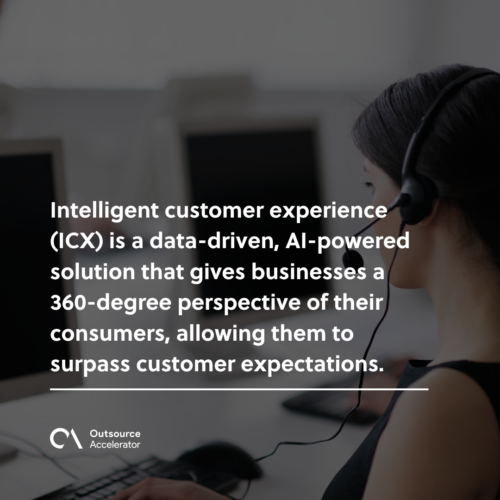Intelligent customer experience (ICX)
Definition
What is an intelligent customer experience (ICX)?
Intelligent customer experience (ICX) is a data-driven, AI-powered solution that gives businesses a 360-degree perspective of their consumers, allowing them to surpass customer expectations.
ICX content responds to the situation and the needs of the consumer. By listening to consumer data and responding in real time with the appropriate information, organizations automatically generate adaptive connections.
Consumers benefit from these new-era experiences because they offer relevant and valuable content across channels, eliminating human labor and transaction barriers.

5 characteristics of intelligent customer experience (ICX)
Here are the five characteristics of intelligent customer experience:
Conversational
Customer experience and intelligent content are interconnected. Using a blend of human and machine intelligence, ICX connects with consumers through intent and response engagements, such as chatbots and voice interfaces.
Issues connected to content influence the consumer experience. Organized, intelligent information will become increasingly important in modern consumer interactions.
Omnichannel
An ICX map creates coordinated and unique consumer experiences across multiple channels, platforms, and devices by combining content modules.
Contextual
An intelligent customer experience understands the context of a customer’s needs and makes that data available for real-time sessions. Bringing together relevant information collection in the formats and perspectives that consumers want.
Automated
Conditional logic is used to allow rapid and long-term consumer journeys without the need for human interaction.
What are the steps toward smarter customer interactions?
Here is how to achieve smarter customer interaction, based on the steps outlined by content intelligence service platform Simple A.
Step 1: Create a vision for customer experience
To create specific and targeted goals, companies can conduct workshops with the aim of creating an updated customer journey map. This will help visualize what a responsive experience should look like.
Step 2: Examine the content ecosystem
It’s important to map the current content process not only to understand the customer experience but also to determine the roles and systems involved in it and how they work together.
Step 3: Coordinate the content process
After having an understanding of the whole content ecosystem, it is important to ensure that every component, system, and team member is interconnected. This way, customers can get a more unified and holistic content experience across different platforms.
This can be achieved by developing a content system that allows everyone to track the customer journey consistently.
Step 4: Upgrade content technology
Upgrading content technology utilizes the new internal structure and semantic standards. Companies can integrate technological platforms and content templates.
Step 5: Update organization and operations
In order to maintain an intelligent customer experience, content operations should be regularly reviewed and updated. This means rethinking processes and expanding teams to satisfy the growing demands for intelligent content.







 Independent
Independent




